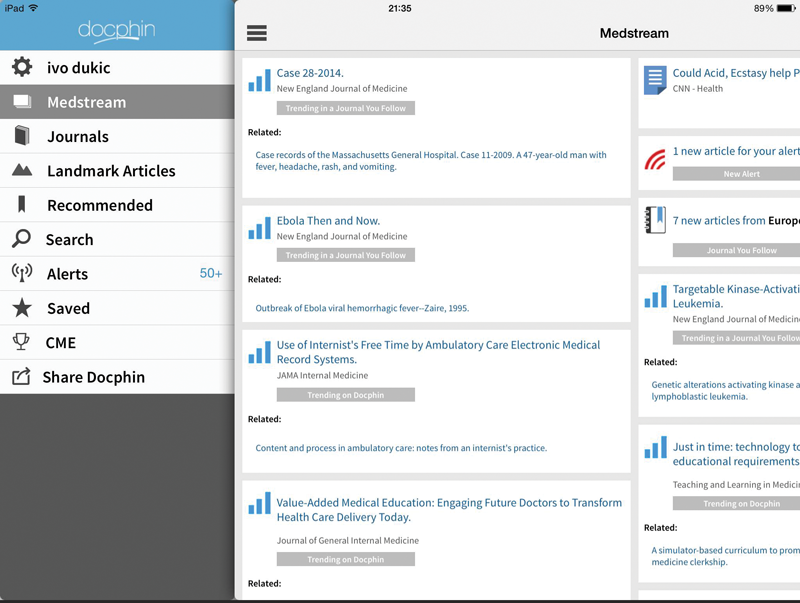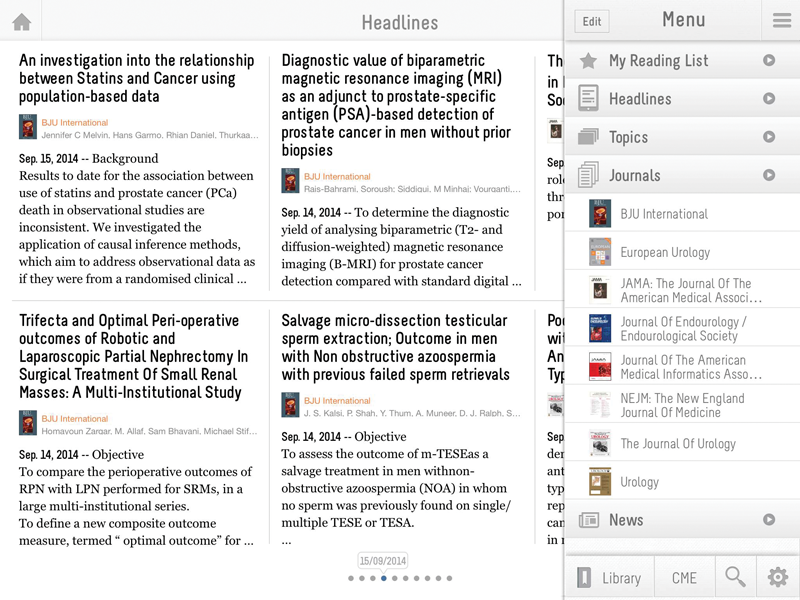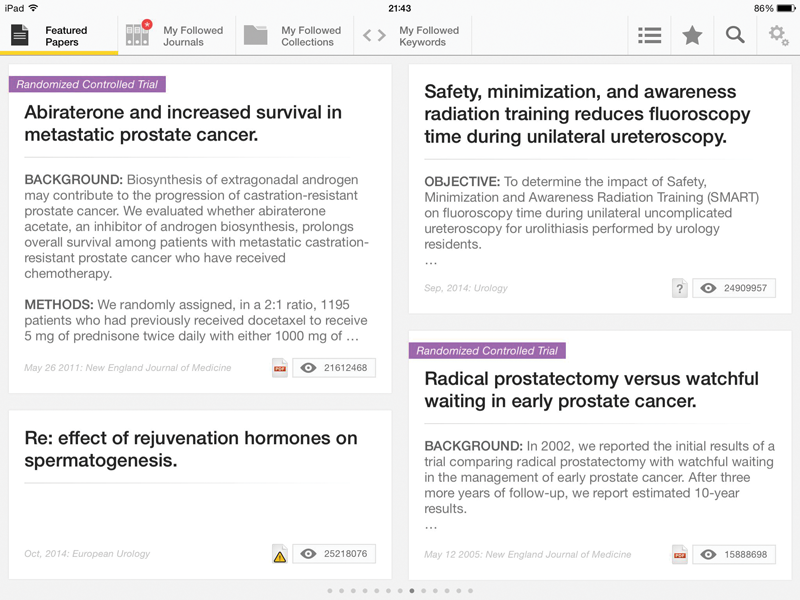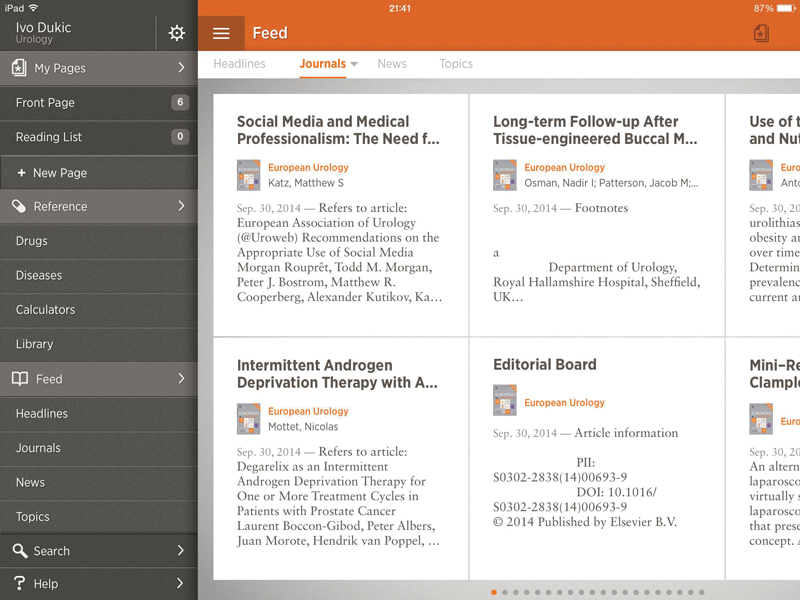Keeping up to date with a variety of urology and medical journals can be an onerous task. Each year there is an ever-expanding number of medical journals and finding a way to sift through relevant information in medical journals and keep up to date is becoming increasingly difficult.
In mainstream news, tablet computers have enabled the creation of personalised news aggregators, which offer an interactive and easy to use interface, famous examples being Flipboard and Zite apps. By selecting the topics you would like to keep updated on, these applications create digital automated magazines, which are tailored to your interests. Now a similar breed of applications focusing on medical journals has emerged into the marketplace.
This digital review focuses on four of the leading medical journal reader apps. All of the apps are available for free. These can be downloaded for iOS devices via the App Store and for android devices via Google Play. The journal readers all link via a NHS Athens account or your university library proxy access directly to medical journals so that you can view full texts of articles and abstracts more efficiently. They also share a number of other features including the ability to share articles via other social media sources such as Twitter and Facebook.
Docphin
Docphin has a number of ways of exploring articles, the most ‘magazine like’ is the ‘Medstream’ view which aggregates articles relevant to your interests. The journal section allows you to add journals from a library of over 5000, including the majority of the most popular urology journals. It stores collections of landmark articles for 40 different specialities, although there currently is an overrepresentation of landmark urology articles from the New England Journal of Medicine. Additionally, if you are interested in particular keywords, the app will notify you of any new articles relating to that topic.

A number of American university institutions are currently using it as part of their residency programmes to make landmark articles, and local policies available through mobile devices. Residents can also be part of journal clubs and postgraduate level quizzes. As you can tell, the app is still mainly focused on its business and consumer model in the United States and the majority of libraries that are directly linked with Docphin are based across the Atlantic. There is also a premium service ($14.95/month), which allows you to keep up to date with particular authors, earn continuing medical education (CME) points and has an advanced search capability.
DocWise
After an initial set-up relating to your specialty, DocWise has an excellent magazine-like user interface with key articles being displayed in a grid which the user can swipe across. All of the most popular urology journals are present in the journal list. Touching each grid section takes you to an abstract section. From there you can read an entire article with a further touch.

Although DocWise has a superior user interface, I was unable to make any abstracts link directly to any full text articles. It may be that reading entire articles is currently not working for Athens users.
The potential is there for this to be an excellent app and there are multiple universities in the United Kingdom who are able to connect directly through this app.
Read by QxMD
Read by QxMD has a similar layout to DocWise, in that articles are presented in a grid format. Touching on a section of the grid loads an abstract in a window and a further touch loads the full text of the article.

Sections are divided into featured papers, my followed journals, my followed collections and my followed keywords. It provides an excellent platform to read full text articles. An interesting feature includes topic reviews, although at present these are fairly limited for urology. The most useful feature is the ability to create and publish entire collections of journal articles which can be read by others. In the future, this feature should enable comprehensive reviews of particular topics as well as key summary articles for exam revision.
Omnio
Developed by SkyScape, Omnio has a bold claim that it can provide everything you need in one medical app. This free app contains a drug database, the Merck Manual, a number of medical calculators and provides a medical journal reader.

Journals are presented in a grid fashion, similar to the Read and DocWise apps. Unfortunately, much like DocWise, I was unable to load full articles via my Athens account using this app. However, they do provide access to a number of UK university institutions through the app.
The other parts are useful additions and provide a good resource for looking up the occasional fact. However, overall I feel you are better using a dedicated app such as the BNF app to check drug information and a dedicated calculator app for checking on particular conditions.
Conclusions
These apps are easy to set up and overall more useful than individual urology journal apps. They allow fast access to summaries of the latest research across a variety of the most relevant medical journals. It’s hard to pick a winner, and a lot will come down to whether your institution is linked to a particular app as this greatly facilitates the ease of use and direct access to full text articles.
DocWise has the best user interface, Omnio and Docphin seem to have the broadest scope, and Read allows for the greatest customisation options. At present, all the apps are free, and I think each user will have his/her favourite. So I encourage everyone to download at least one of the medical journal apps to your smartphone or tablet.





